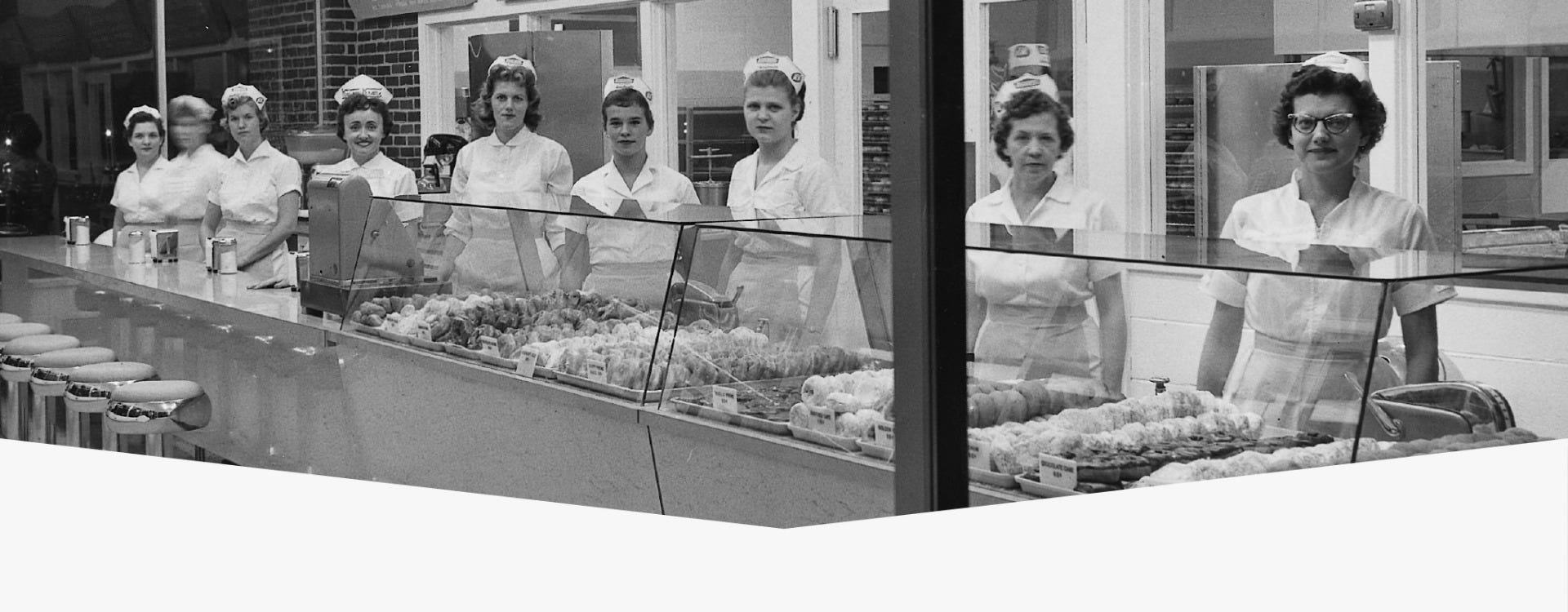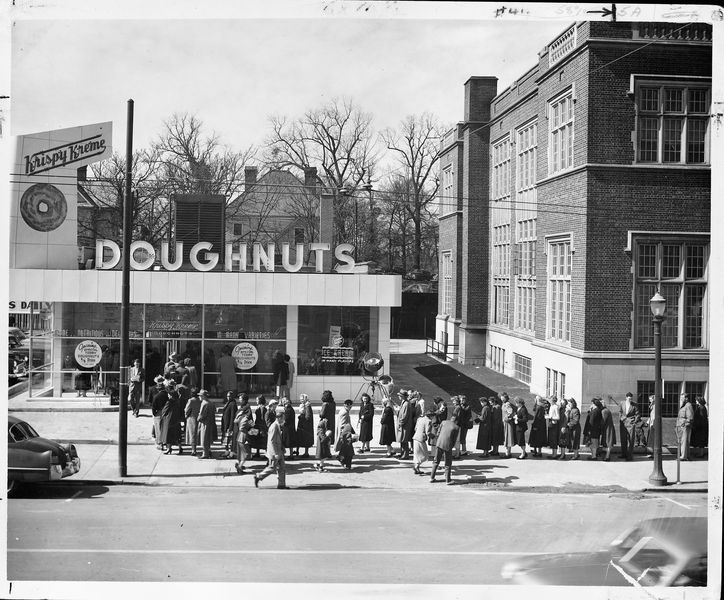Can a single glazed doughnut truly change the world? Krispy Kremes journey from a humble North Carolina operation to a global phenomenon proves that a simple treat, coupled with savvy business acumen, can indeed leave a lasting impact. The story of Krispy Kreme is more than just the tale of a beloved doughnut; its a chronicle of entrepreneurial spirit, strategic adaptation, and the enduring power of a delicious, freshly made product.
It all began in 1937, in Winston-Salem, North Carolina. Vernon Rudolph, a young man with a knack for baking, purchased a yeast-raised doughnut recipe from a New Orleans chef. He initially sold his doughnuts to local grocery stores, but the intoxicating aroma of his freshly baked treats proved too tempting to resist. People began to gather outside his shop, drawn by the promise of a warm, melt-in-your-mouth doughnut. Rudolph, recognizing the potential of this spontaneous gathering, cut a hole in the wall of his shop, allowing passersby to witness the doughnut-making process. This innovation wasnt just a novelty; it was a pivotal moment that transformed Krispy Kreme from a simple bakery into a spectacle, an experience, and an irresistible temptation.
The popularity of Krispy Kreme doughnuts quickly spread, fueled by word-of-mouth and the irresistible allure of that Hot Doughnuts Now sign. The sign, a beacon of deliciousness, became a defining feature of the Krispy Kreme brand. As the company grew, Rudolph understood the importance of consistency and quality. He meticulously standardized recipes and processes, ensuring that every doughnut, regardless of location, delivered the same delightful experience. This commitment to quality, combined with a smart business model, laid the foundation for Krispy Kremes future success.
The post-World War II era saw a surge in franchising opportunities, and Krispy Kreme capitalized on this trend. Franchises began to sprout across the southeastern United States, each one replicating Rudolphs commitment to quality and the enchanting "Hot Doughnuts Now" experience. This expansion, however, wasnt without its challenges. Maintaining consistent quality control across multiple franchises required diligent management and rigorous adherence to the established standards. Despite these hurdles, Krispy Kremes brand recognition continued to grow, solidifying its place in the American cultural landscape.
Throughout the decades, Krispy Kreme faced competition from larger, more established players in the food industry. However, the company maintained its focus on its core values: quality ingredients, freshly made doughnuts, and a customer experience centered around the "Hot Doughnuts Now" phenomenon. The company also innovated its product offerings, introducing a variety of doughnut flavors and seasonal specials to keep its customers engaged and coming back for more.
The 1960s and 1970s were a period of further expansion, with Krispy Kreme doughnuts becoming available in more and more locations. By this time, the Krispy Kreme brand was already deeply ingrained in the American consciousness. The company's iconic logo, with its familiar script and red and green colors, became instantly recognizable, a symbol of warmth, comfort, and a delicious indulgence. The doughnuts themselves had become a symbol of simple pleasures, something to be shared with friends and family, something to be enjoyed on a special occasion or simply as a treat.
However, the 1990s and early 2000s brought a significant turning point. Krispy Kreme went public in 2000, and the company's stock soared, fueled by investor enthusiasm and the anticipation of further expansion. This period saw an aggressive expansion strategy, with new stores opening at a rapid pace, both domestically and internationally. The company expanded into new markets, including Canada, the United Kingdom, Australia, and Asia. This rapid growth, while initially successful, also presented significant challenges. Managing the logistics of global expansion, maintaining consistent quality across multiple locations, and adapting to different cultural preferences required significant resources and expertise.
The pressure of expansion, coupled with operational inefficiencies and accounting irregularities, eventually led to a period of significant financial difficulties. The company's stock price plummeted, and Krispy Kreme found itself struggling to maintain profitability. This period was a harsh reminder of the challenges of rapid growth and the importance of maintaining financial discipline. The company was forced to re-evaluate its strategies and implement changes to stabilize its financial position.
The early 2000s exposed flaws in the company's expansion strategy. Rapid growth led to dilution of brand equity, as the focus shifted from maintaining quality to simply opening new stores. Overexpansion in some markets resulted in cannibalization, where new stores competed with existing ones for customers. The company also faced scrutiny regarding its accounting practices, adding to the challenges. This period was a lesson in the dangers of prioritizing growth over sustainable business practices. It highlighted the importance of financial transparency, operational efficiency, and the careful management of brand reputation.
In response to these challenges, Krispy Kreme underwent a period of restructuring. The company brought in new management, who focused on streamlining operations, improving financial controls, and strengthening the brand. The emphasis shifted from rapid expansion to sustainable growth, with a renewed focus on the core values that had made Krispy Kreme so successful in the first place: quality, freshness, and the customer experience. The company also closed underperforming stores and divested itself of non-core assets.
One of the key strategies implemented during this period was a renewed focus on the "Hot Doughnuts Now" experience. The company invested in upgrading its equipment and processes, ensuring that doughnuts were consistently fresh and delicious. The "Hot Doughnuts Now" sign continued to be a powerful marketing tool, attracting customers to stores and creating a sense of excitement and anticipation. The company also invested in its employees, providing training and support to ensure that they were able to deliver the highest levels of customer service.
The company also embraced technology, introducing new digital initiatives to improve its operations and enhance the customer experience. Online ordering, mobile apps, and loyalty programs were implemented to make it easier for customers to purchase their favorite doughnuts. The company also leveraged social media to connect with its customers, building a strong online presence and engaging with its audience. This commitment to technology helped Krispy Kreme stay relevant in a changing marketplace and appeal to a new generation of customers.
The turnaround efforts of the mid-2000s, coupled with strategic partnerships and innovative product offerings, helped Krispy Kreme regain its footing. The company formed strategic alliances with retailers like Walmart and grocery stores, expanding its reach and making its doughnuts more accessible to consumers. Krispy Kreme also introduced new flavors, seasonal offerings, and special promotions, attracting new customers and keeping existing ones engaged. The companys commitment to innovation helped it maintain a competitive edge in a dynamic market.
The company also developed new doughnut varieties, including the "Original Filled" doughnut, which added a new dimension to the classic Krispy Kreme experience. Krispy Kreme also embraced seasonal flavors, introducing limited-time offerings that capitalized on popular holidays and events. These innovations helped the company stay relevant and cater to the evolving tastes of its customer base. These marketing strategies played a pivotal role in Krispy Kreme's comeback.
In 2016, Krispy Kreme was acquired by JAB Holding Company, a privately held investment group. This acquisition provided Krispy Kreme with new resources and opportunities for growth. JAB Holding Company has a track record of investing in leading consumer brands, and its acquisition of Krispy Kreme signaled a commitment to the long-term success of the company. The acquisition brought new capital, expertise, and a fresh perspective to Krispy Kreme.
Under JAB Holding Company's ownership, Krispy Kreme has continued to expand its global footprint. The company has opened new stores in key markets around the world and has also focused on expanding its digital presence and developing new products. Krispy Kreme has also invested in its supply chain, ensuring that it can consistently deliver high-quality doughnuts to its customers. This continued global expansion showcases the enduring appeal of the Krispy Kreme brand.
Today, Krispy Kreme operates in numerous countries around the globe. The company has embraced new technologies and marketing strategies while staying true to its core values. Krispy Kreme's commitment to quality, freshness, and customer experience remains at the heart of its success. The company continues to evolve, adapting to the changing needs of its customers and the dynamic nature of the food industry.
Krispy Kremes story serves as a valuable case study for businesses of all sizes. It illustrates the importance of several key elements:
- A Strong Brand: Krispy Kreme has cultivated a powerful brand identity, recognized and loved by consumers worldwide.
- Quality and Consistency: The company has maintained a commitment to quality and consistency, ensuring that every doughnut delivers the same delightful experience.
- Customer Experience: Krispy Kreme has consistently prioritized the customer experience, creating a sense of excitement and anticipation with its "Hot Doughnuts Now" sign and its inviting stores.
- Adaptation and Innovation: The company has adapted to changing market conditions and embraced innovation, introducing new products, technologies, and marketing strategies.
- Financial Discipline: The company has learned the importance of financial discipline, and the need to balance rapid growth with sustainable business practices.
The future for Krispy Kreme looks bright. With its strong brand, its commitment to quality, and its ability to adapt to change, the company is well-positioned to continue to grow and delight customers around the world. The legacy of Vernon Rudolph, the man who started it all, lives on, as Krispy Kreme continues to spread the joy of a perfectly glazed doughnut.
Krispy Kreme has transcended its role as a simple doughnut shop. It has become a cultural icon, a symbol of comfort, and a testament to the power of a well-crafted product. The company's story is a fascinating blend of entrepreneurial spirit, strategic adaptations, and unwavering commitment to its core values. The history of Krispy Kreme is a sweet success story, a reminder that even the simplest of treats can leave a lasting impact.
| Category | Details |
|---|---|
| Founding Date | 1937 |
| Founder | Vernon Rudolph |
| Original Location | Winston-Salem, North Carolina |
| Original Product | Yeast-raised doughnuts |
| Key Innovation | The "Hot Doughnuts Now" sign and the visible doughnut-making process |
| Early Expansion Method | Franchising |
| Public Offering | 2000 |
| Acquisition | 2016 by JAB Holding Company |
| Current Status | Global brand with a presence in numerous countries |
| Iconic Features | Red and green logo, "Hot Doughnuts Now" sign |
For more information, you can visit the official Krispy Kreme website: www.krispykreme.com


![The Shocking History of Krispy Kreme Donuts [2023]](https://americandonutsociety.com/wp-content/uploads/2023/08/originalKrispyKreme-2.jpg)